Liang Pang
Can Synthetic Query Rewrites Capture User Intent Better than Humans in Retrieval-Augmented Generation?
Sep 26, 2025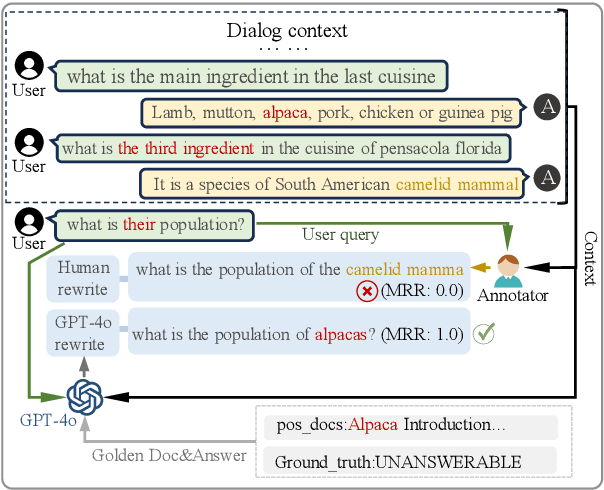



Abstract:Multi-turn RAG systems often face queries with colloquial omissions and ambiguous references, posing significant challenges for effective retrieval and generation. Traditional query rewriting relies on human annotators to clarify queries, but due to limitations in annotators' expressive ability and depth of understanding, manually rewritten queries often diverge from those needed in real-world RAG systems, resulting in a gap between user intent and system response. We observe that high-quality synthetic queries can better bridge this gap, achieving superior performance in both retrieval and generation compared to human rewrites. This raises an interesting question: Can rewriting models trained on synthetic queries better capture user intent than human annotators? In this paper, we propose SynRewrite, a synthetic data-driven query rewriting model to generate high-quality synthetic rewrites more aligned with user intent. To construct training data, we prompt GPT-4o with dialogue history, current queries, positive documents, and answers to synthesize high-quality rewrites. A Flan-T5 model is then finetuned on this dataset to map dialogue history and queries to synthetic rewrites. Finally, we further enhance the rewriter using the generator's feedback through the DPO algorithm to boost end-task performance. Experiments on TopiOCQA and QRECC datasets show that SynRewrite consistently outperforms human rewrites in both retrieval and generation tasks. Our results demonstrate that synthetic rewrites can serve as a scalable and effective alternative to human annotations.
Stop Spinning Wheels: Mitigating LLM Overthinking via Mining Patterns for Early Reasoning Exit
Aug 25, 2025



Abstract:Large language models (LLMs) enhance complex reasoning tasks by scaling the individual thinking process. However, prior work shows that overthinking can degrade overall performance. Motivated by observed patterns in thinking length and content length, we categorize reasoning into three stages: insufficient exploration stage, compensatory reasoning stage, and reasoning convergence stage. Typically, LLMs produce correct answers in the compensatory reasoning stage, whereas reasoning convergence often triggers overthinking, causing increased resource usage or even infinite loops. Therefore, mitigating overthinking hinges on detecting the end of the compensatory reasoning stage, defined as the Reasoning Completion Point (RCP). RCP typically appears at the end of the first complete reasoning cycle and can be identified by querying the LLM sentence by sentence or monitoring the probability of an end-of-thinking token (e.g., \texttt{</think>}), though these methods lack an efficient and precise balance. To improve this, we mine more sensitive and consistent RCP patterns and develop a lightweight thresholding strategy based on heuristic rules. Experimental evaluations on benchmarks (AIME24, AIME25, GPQA-D) demonstrate that the proposed method reduces token consumption while preserving or enhancing reasoning accuracy.
Distilling the Implicit Multi-Branch Structure in LLMs' Reasoning via Reinforcement Learning
May 22, 2025Abstract:Distilling reasoning paths from teacher to student models via supervised fine-tuning (SFT) provides a shortcut for improving the reasoning ability of smaller Large Language Models (LLMs). However, the reasoning paths generated by teacher models often reflect only surface-level traces of their underlying authentic reasoning. Insights from cognitive neuroscience suggest that authentic reasoning involves a complex interweaving between meta-reasoning (which selects appropriate sub-problems from multiple candidates) and solving (which addresses the sub-problem). This implies authentic reasoning has an implicit multi-branch structure. Supervised fine-tuning collapses this rich structure into a flat sequence of token prediction in the teacher's reasoning path, preventing effective distillation of this structure to students. To address this limitation, we propose RLKD, a reinforcement learning (RL)-based distillation framework guided by a novel Generative Structure Reward Model (GSRM). Our GSRM converts reasoning paths into multiple meta-reasoning-solving steps and computes rewards to measure structural alignment between student and teacher reasoning. RLKD combines this reward with RL, enabling student LLMs to internalize the teacher's implicit multi-branch reasoning structure rather than merely mimicking fixed output paths. Experiments show RLKD surpasses standard SFT-RL pipelines even when trained on 0.1% of data under an RL-only regime, unlocking greater student reasoning potential than SFT-based distillation.
NExT-Search: Rebuilding User Feedback Ecosystem for Generative AI Search
May 20, 2025Abstract:Generative AI search is reshaping information retrieval by offering end-to-end answers to complex queries, reducing users' reliance on manually browsing and summarizing multiple web pages. However, while this paradigm enhances convenience, it disrupts the feedback-driven improvement loop that has historically powered the evolution of traditional Web search. Web search can continuously improve their ranking models by collecting large-scale, fine-grained user feedback (e.g., clicks, dwell time) at the document level. In contrast, generative AI search operates through a much longer search pipeline, spanning query decomposition, document retrieval, and answer generation, yet typically receives only coarse-grained feedback on the final answer. This introduces a feedback loop disconnect, where user feedback for the final output cannot be effectively mapped back to specific system components, making it difficult to improve each intermediate stage and sustain the feedback loop. In this paper, we envision NExT-Search, a next-generation paradigm designed to reintroduce fine-grained, process-level feedback into generative AI search. NExT-Search integrates two complementary modes: User Debug Mode, which allows engaged users to intervene at key stages; and Shadow User Mode, where a personalized user agent simulates user preferences and provides AI-assisted feedback for less interactive users. Furthermore, we envision how these feedback signals can be leveraged through online adaptation, which refines current search outputs in real-time, and offline update, which aggregates interaction logs to periodically fine-tune query decomposition, retrieval, and generation models. By restoring human control over key stages of the generative AI search pipeline, we believe NExT-Search offers a promising direction for building feedback-rich AI search systems that can evolve continuously alongside human feedback.
Understanding Accuracy-Fairness Trade-offs in Re-ranking through Elasticity in Economics
Apr 21, 2025Abstract:Fairness is an increasingly important factor in re-ranking tasks. Prior work has identified a trade-off between ranking accuracy and item fairness. However, the underlying mechanisms are still not fully understood. An analogy can be drawn between re-ranking and the dynamics of economic transactions. The accuracy-fairness trade-off parallels the coupling of the commodity tax transfer process. Fairness considerations in re-ranking, similar to a commodity tax on suppliers, ultimately translate into a cost passed on to consumers. Analogously, item-side fairness constraints result in a decline in user-side accuracy. In economics, the extent to which commodity tax on the supplier (item fairness) transfers to commodity tax on users (accuracy loss) is formalized using the notion of elasticity. The re-ranking fairness-accuracy trade-off is similarly governed by the elasticity of utility between item groups. This insight underscores the limitations of current fair re-ranking evaluations, which often rely solely on a single fairness metric, hindering comprehensive assessment of fair re-ranking algorithms. Centered around the concept of elasticity, this work presents two significant contributions. We introduce the Elastic Fairness Curve (EF-Curve) as an evaluation framework. This framework enables a comparative analysis of algorithm performance across different elasticity levels, facilitating the selection of the most suitable approach. Furthermore, we propose ElasticRank, a fair re-ranking algorithm that employs elasticity calculations to adjust inter-item distances within a curved space. Experiments on three widely used ranking datasets demonstrate its effectiveness and efficiency.
Learning to Erase Private Knowledge from Multi-Documents for Retrieval-Augmented Large Language Models
Apr 14, 2025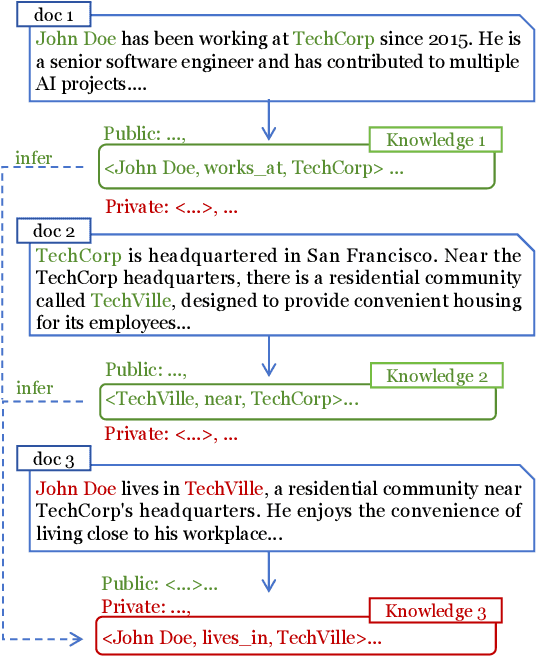



Abstract:Retrieval-Augmented Generation (RAG) is a promising technique for applying LLMs to proprietary domains. However, retrieved documents may contain sensitive knowledge, posing risks of privacy leakage in generative results. Thus, effectively erasing private information from retrieved documents is a key challenge for RAG. Unlike traditional text anonymization, RAG should consider: (1) the inherent multi-document reasoning may face de-anonymization attacks; (2) private knowledge varies by scenarios, so users should be allowed to customize which information to erase; (3) preserving sufficient publicly available knowledge for generation tasks. This paper introduces the privacy erasure task for RAG and proposes Eraser4RAG, a private knowledge eraser which effectively removes user-defined private knowledge from documents while preserving sufficient public knowledge for generation. Specifically, we first construct a global knowledge graph to identify potential knowledge across documents, aiming to defend against de-anonymization attacks. Then we randomly split it into private and public sub-graphs, and fine-tune Flan-T5 to rewrite the retrieved documents excluding private triples. Finally, PPO algorithm optimizes the rewriting model to minimize private triples and maximize public triples retention. Experiments on four QA datasets demonstrate that Eraser4RAG achieves superior erase performance than GPT-4o.
LightPROF: A Lightweight Reasoning Framework for Large Language Model on Knowledge Graph
Apr 04, 2025Abstract:Large Language Models (LLMs) have impressive capabilities in text understanding and zero-shot reasoning. However, delays in knowledge updates may cause them to reason incorrectly or produce harmful results. Knowledge Graphs (KGs) provide rich and reliable contextual information for the reasoning process of LLMs by structurally organizing and connecting a wide range of entities and relations. Existing KG-based LLM reasoning methods only inject KGs' knowledge into prompts in a textual form, ignoring its structural information. Moreover, they mostly rely on close-source models or open-source models with large parameters, which poses challenges to high resource consumption. To address this, we propose a novel Lightweight and efficient Prompt learning-ReasOning Framework for KGQA (LightPROF), which leverages the full potential of LLMs to tackle complex reasoning tasks in a parameter-efficient manner. Specifically, LightPROF follows a "Retrieve-Embed-Reason process", first accurately, and stably retrieving the corresponding reasoning graph from the KG through retrieval module. Next, through a Transformer-based Knowledge Adapter, it finely extracts and integrates factual and structural information from the KG, then maps this information to the LLM's token embedding space, creating an LLM-friendly prompt to be used by the LLM for the final reasoning. Additionally, LightPROF only requires training Knowledge Adapter and can be compatible with any open-source LLM. Extensive experiments on two public KGQA benchmarks demonstrate that LightPROF achieves superior performance with small-scale LLMs. Furthermore, LightPROF shows significant advantages in terms of input token count and reasoning time.
Perplexity Trap: PLM-Based Retrievers Overrate Low Perplexity Documents
Mar 11, 2025



Abstract:Previous studies have found that PLM-based retrieval models exhibit a preference for LLM-generated content, assigning higher relevance scores to these documents even when their semantic quality is comparable to human-written ones. This phenomenon, known as source bias, threatens the sustainable development of the information access ecosystem. However, the underlying causes of source bias remain unexplored. In this paper, we explain the process of information retrieval with a causal graph and discover that PLM-based retrievers learn perplexity features for relevance estimation, causing source bias by ranking the documents with low perplexity higher. Theoretical analysis further reveals that the phenomenon stems from the positive correlation between the gradients of the loss functions in language modeling task and retrieval task. Based on the analysis, a causal-inspired inference-time debiasing method is proposed, called Causal Diagnosis and Correction (CDC). CDC first diagnoses the bias effect of the perplexity and then separates the bias effect from the overall estimated relevance score. Experimental results across three domains demonstrate the superior debiasing effectiveness of CDC, emphasizing the validity of our proposed explanatory framework. Source codes are available at https://github.com/WhyDwelledOnAi/Perplexity-Trap.
FineFilter: A Fine-grained Noise Filtering Mechanism for Retrieval-Augmented Large Language Models
Feb 18, 2025



Abstract:Retrieved documents containing noise will hinder Retrieval-Augmented Generation (RAG) from detecting answer clues, necessitating noise filtering mechanisms to enhance accuracy. Existing methods use re-ranking or summarization to identify the most relevant sentences, but directly and accurately locating answer clues from these large-scale and complex documents remains challenging. Unlike these document-level operations, we treat noise filtering as a sentence-level MinMax optimization problem: first identifying the potential clues from multiple documents using contextual information, then ranking them by relevance, and finally retaining the least clues through truncation. In this paper, we propose FineFilter, a novel fine-grained noise filtering mechanism for RAG consisting of a clue extractor, a re-ranker, and a truncator. We optimize each module to tackle complex reasoning challenges: (1) Clue extractor firstly uses sentences containing the answer and similar ones as fine-tuned targets, aiming at extracting sufficient potential clues; (2) Re-ranker is trained to prioritize effective clues based on the real feedback from generation module, with clues capable of generating correct answer as positive samples and others as negative; (3) Truncator takes the minimum clues needed to answer the question (truncation point) as fine-tuned targets, and performs truncation on the re-ranked clues to achieve fine-grained noise filtering. Experiments on three QA datasets demonstrate that FineFilter significantly outperforms baselines in terms of performance and inference cost. Further analysis on each module shows the effectiveness of our optimizations for complex reasoning.
ToolCoder: A Systematic Code-Empowered Tool Learning Framework for Large Language Models
Feb 17, 2025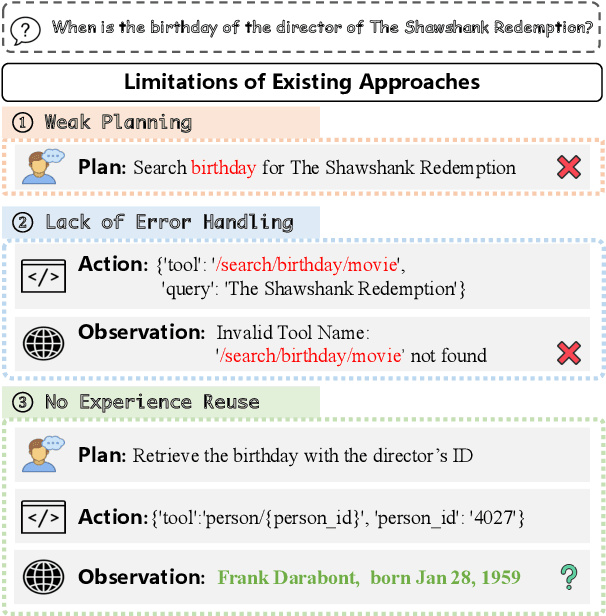
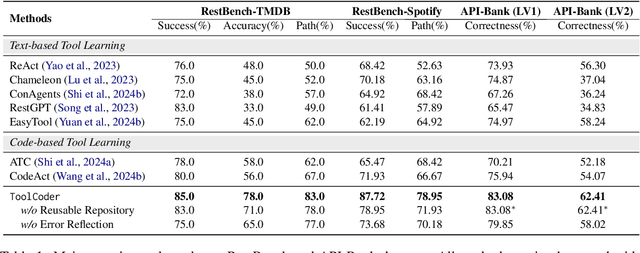
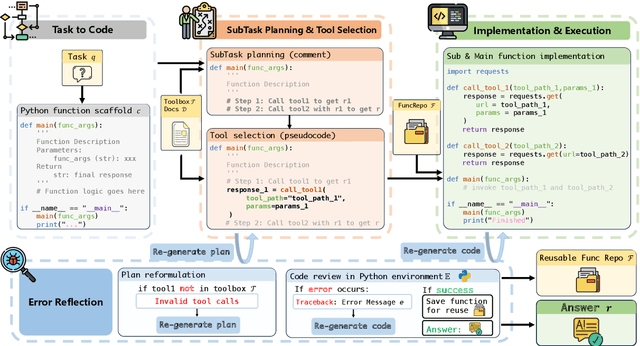
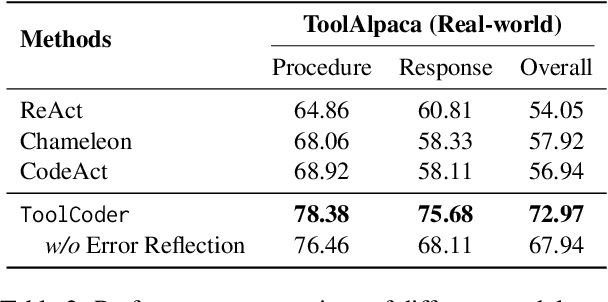
Abstract:Tool learning has emerged as a crucial capability for large language models (LLMs) to solve complex real-world tasks through interaction with external tools. Existing approaches face significant challenges, including reliance on hand-crafted prompts, difficulty in multi-step planning, and lack of precise error diagnosis and reflection mechanisms. We propose ToolCoder, a novel framework that reformulates tool learning as a code generation task. Inspired by software engineering principles, ToolCoder transforms natural language queries into structured Python function scaffold and systematically breaks down tasks with descriptive comments, enabling LLMs to leverage coding paradigms for complex reasoning and planning. It then generates and executes function implementations to obtain final responses. Additionally, ToolCoder stores successfully executed functions in a repository to promote code reuse, while leveraging error traceback mechanisms for systematic debugging, optimizing both execution efficiency and robustness. Experiments demonstrate that ToolCoder achieves superior performance in task completion accuracy and execution reliability compared to existing approaches, establishing the effectiveness of code-centric approaches in tool learning.
 Add to Chrome
Add to Chrome Add to Firefox
Add to Firefox Add to Edge
Add to Edge